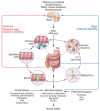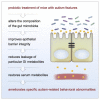The Brain-Gut-Microbiome System: Pathways and Implications for Autism Spectrum Disorder
- PMID: 34960049
- PMCID: PMC8704412
- DOI: 10.3390/nu13124497
The Brain-Gut-Microbiome System: Pathways and Implications for Autism Spectrum Disorder
Abstract
Gastrointestinal dysfunction is one of the most prevalent physiological symptoms of autism spectrum disorder (ASD). A growing body of largely preclinical research suggests that dysbiotic gut microbiota may modulate brain function and social behavior, yet little is known about the mechanisms that underlie these relationships and how they may influence the pathogenesis or severity of ASD. While various genetic and environmental risk factors have been implicated in ASD, this review aims to provide an overview of studies elucidating the mechanisms by which gut microbiota, associated metabolites, and the brain interact to influence behavior and ASD development, in at least a subgroup of individuals with gastrointestinal problems. Specifically, we review the brain-gut-microbiome system and discuss findings from current animal and human studies as they relate to social-behavioral and neurological impairments in ASD, microbiota-targeted therapies (i.e., probiotics, fecal microbiota transplantation) in ASD, and how microbiota may influence the brain at molecular, structural, and functional levels, with a particular interest in social and emotion-related brain networks. A deeper understanding of microbiome-brain-behavior interactions has the potential to inform new therapies aimed at modulating this system and alleviating both behavioral and physiological symptomatology in individuals with ASD.
Keywords: autism spectrum disorder; brain-gut-microbiome system; gut-brain axis; microbiome; probiotics; tryptophan pathway.
Conflict of interest statement
E.A.M. is a scientific advisory board member of Danone, Axial Biotherapeutics, Viome, Amare, Mahana Therapeutics, Pendulum, Bloom Biosciences, APC Microbiome Ireland.
Figures




Similar articles
-
The Human Gut Microbiome as a Potential Factor in Autism Spectrum Disorder.Int J Mol Sci. 2022 Jan 25;23(3):1363. doi: 10.3390/ijms23031363. Int J Mol Sci. 2022. PMID: 35163286 Free PMC article. Review.
-
Autism Spectrum Disorder as a Brain-Gut-Microbiome Axis Disorder.Dig Dis Sci. 2020 Mar;65(3):818-828. doi: 10.1007/s10620-020-06133-5. Dig Dis Sci. 2020. PMID: 32056091 Free PMC article. Review.
-
The complex interplay between autism spectrum disorder and gut microbiota in children: A comprehensive review.Behav Brain Res. 2024 Sep 13;473:115177. doi: 10.1016/j.bbr.2024.115177. Epub 2024 Aug 2. Behav Brain Res. 2024. PMID: 39098397 Review.
-
The microbiota-gut-brain axis and its potential therapeutic role in autism spectrum disorder.Neuroscience. 2016 Jun 2;324:131-9. doi: 10.1016/j.neuroscience.2016.03.013. Epub 2016 Mar 8. Neuroscience. 2016. PMID: 26964681 Review.
-
Microbiota-gut-brain axis in autism spectrum disorder.J Genet Genomics. 2021 Sep 20;48(9):755-762. doi: 10.1016/j.jgg.2021.07.001. Epub 2021 Jul 19. J Genet Genomics. 2021. PMID: 34373221 Review.
Cited by
-
The Diagnosis and Management of Autism Spectrum Disorder (ASD) in Adult Females in the Presence or Absence of an Intellectual Disability.Int J Environ Res Public Health. 2022 Jan 25;19(3):1315. doi: 10.3390/ijerph19031315. Int J Environ Res Public Health. 2022. PMID: 35162336 Free PMC article. Review.
-
Gut Microbiota Ecology and Inferred Functions in Children With ASD Compared to Neurotypical Subjects.Front Microbiol. 2022 Jun 9;13:871086. doi: 10.3389/fmicb.2022.871086. eCollection 2022. Front Microbiol. 2022. PMID: 35756062 Free PMC article.
-
The Causal Effects between Mood Swings and Gastrointestinal Diseases: A Mendelian Randomization Study.Alpha Psychiatry. 2024 Aug 1;25(4):533-540. doi: 10.5152/alphapsychiatry.2024.241688. eCollection 2024 Aug. Alpha Psychiatry. 2024. PMID: 39360292 Free PMC article.
-
Gut microbiota composition and metabolic characteristics in patients with Craniopharyngioma.BMC Cancer. 2024 Apr 25;24(1):521. doi: 10.1186/s12885-024-12283-w. BMC Cancer. 2024. PMID: 38658858 Free PMC article.
-
Additive or Interactive Associations of Food Allergies with Glutathione S-Transferase Genes in Relation to ASD and ASD Severity in Jamaican Children.J Autism Dev Disord. 2024 Feb;54(2):704-724. doi: 10.1007/s10803-022-05813-7. Epub 2022 Nov 27. J Autism Dev Disord. 2024. PMID: 36436147
References
-
- American Psychiatric Association . Diagnostic and Statistical Manual of Mental Disorders. 5th ed. American Psychiatric Publishing, Inc.; Arlington, VA, USA: 2013.

